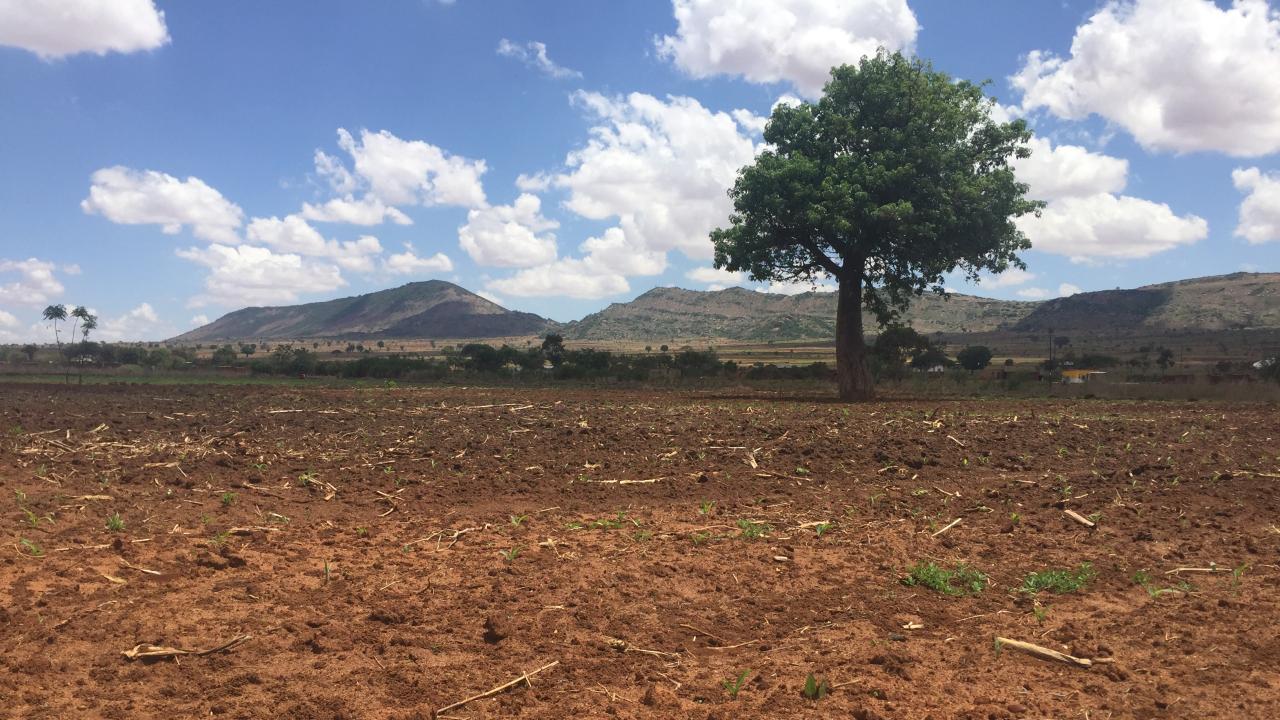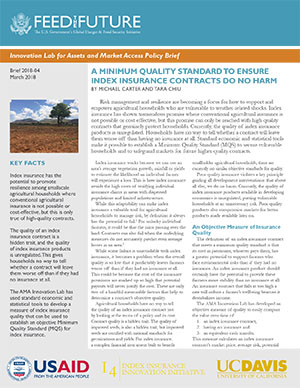
Risk management and resilience are becoming a focus for how to support and empower agricultural households who are vulnerable to weather-related shocks. Index insurance has shown tremendous promise where conventional agricultural insurance is not possible or cost-effective, but this promise can only be reached with high-quality contracts that genuinely protect households.
Currently, the quality of index insurance products is unregulated. Households have no way to tell whether a contract will leave them worse off than having no insurance at all. Standard economic and statistical tools make it possible to establish a Minimum Quality Standard (MQS) to secure vulnerable households and to safeguard markets for future higher-quality contracts.
Highlights
- Index insurance has the potential to promote resilience among small-scale agricultural households where conventional agricultural insurance is not possible or cost-effective, but this is only true of high-quality contracts.
- The quality of an index insurance contract is a hidden trait, and the quality of index insurance products is unregulated. This gives households no way to tell whether a contract will leave them worse off than if they had no insurance at all.
- The AMA Innovation Lab has used standard economic and statistical tools to develop a measure of index insurance quality that can be used to establish an objective Minimum Quality Standard (MQS) for index insurance.
Index insurance works because we can use an area’s average vegetation growth, rainfall or yields to estimate the likelihood an individual farmer will experience a loss. This is how index insurance avoids the high costs of verifying individual insurance claims in areas with dispersed populations and limited infrastructure.
While this adaptability can make index insurance a valuable tool for agricultural households to manage risk, by definition it always has the potential to fail.[1] For unlucky individual farmers, it could be that the rains passing over the land. Contracts can also fail when the underlying measures do not accurately predict even average losses in an area.[2]
While some failure is unavoidable with index insurance, it becomes a problem when the overall quality is so low that it predictably leaves farmers worse off than if they had no insurance at all. This could be because the cost of the insurance premiums are marked up so high that potential payouts will never justify the cost. These are only two of a handful measurable factors that help to determine a contract’s objective quality.
Agricultural households have no way to tell the quality of an index insurance contract just by looking at the terms of a policy and its cost. Contract quality is a hidden trait. The quality of improved seeds, is also a hidden trait, but improved seeds are certified with national standards for germinations and yields. For index insurance, a complex financial instrument built to benefit smallholder agricultural households, there are currently no similar objective standards for quality.
Poor-quality insurance violates a key principle guiding all development interventions: that above all else, we do no harm. Currently, the quality of index insurance products available in developing economies is unregulated, putting vulnerable households at an unnecessary risk. Poor-quality products also compromise markets for better products made available later on.
An Objective Measure of Insurance Quality
 The definition of an index insurance contract that meets a minimum quality standard is that its cost in premiums, whoever pays them, has a greater potential to support farmers who face environmental risks than if they had no insurance. An index insurance product should certainly have the potential to provide these farmers more stability than no insurance at all. An insurance contract that fails at too high a rate will reduce a farmer’s wellbeing because it destabilizes income.
The definition of an index insurance contract that meets a minimum quality standard is that its cost in premiums, whoever pays them, has a greater potential to support farmers who face environmental risks than if they had no insurance. An index insurance product should certainly have the potential to provide these farmers more stability than no insurance at all. An insurance contract that fails at too high a rate will reduce a farmer’s wellbeing because it destabilizes income.
The AMA Innovation Lab has developed an objective measure of quality to easily compare the value over time of
- an index insurance contract,
- having no insurance and
- an equivalent cash transfer.
This measure calculates an index insurance contract’s market price, average risk, potential payouts and farmer income/consumption into a comparable expected utility value.[3]
Importantly, comparing the value of having index insurance and having no insurance at all establishes whether a specific contract meets what we call a “Minimum Quality Standard.” The purpose of insurance is to leave farmers better off than if they had no insurance at all. A Minimum Quality Standard based on the simple comparison of our index insurance quality measure’s expected utility value provides a clear and objective definition of when—at a minimum—a contract is likely to leave farmers better off. A good contract should of course exceed this minimum standard and make farmers much better off than if they had no insurance.
Using the tool requires historical data on the index measure and yields that are needed to develop an index insurance contract and also historical data on household income/consumption. This additional household data is critical for determining how the performance of an index insurance contract affects a family’s level of need in the event of a shock. It is also not expensive to collect. In a recent Nepal feasibility study,[4] our cost for collecting this data from about 600 households was about $15,000.
Beyond establishing minimum quality, our measure also can establish whether an index insurance contract is a cost-effective means to support farmers’ wellbeing. From the perspective of donor or government subsidies, index insurance should have a better dollar-for-dollar potential to provide stability than an equivalent direct cash transfer.
Certifying Minimum Insurance Quality
The stakes for index insurance quality are high. When an index insurance contract fails, a farmer faces a crop loss in addition to the money spent on insurance. The situation is especially dire if having insurance motivated her to take out a loan to invest in higher productivity. In a bad year, she would lose all her income and have no way to repay the loan. Without a certification for quality, it can take years before a catastrophe makes the difference clear. By then it’s too late.
Establishing how to objectively measure index insurance quality and defining a minimum standard is only the first step. Because there is no inherent incentive for high-quality contracts, the next steps involve the broad adoption of a certification to ensure that index insurance products available to smallholder agricultural households meet a Minimum Quality Standard.
Examples of systems that could work involve a body of technical specialists who conduct objective tests for levels of quality that meet government or donor regulatory requirements. For example, national seed sectors rely on germination and yield testing from their own ministries of agriculture. Market-based examples include UL, which provides safety and other certifications, and ISO, which develops international standards.
Subsidies to pay for index insurance coverage do not change the need for a Minimum Quality Standard. They may, in fact, make it even more needed. The money a government or donor organization spends on low-quality insurance for farmers is money diverted from spending that can have a greater impact. This includes cash transfers directly to farmers.
For individual farmers, a certification for an index insurance Minimum Quality Standard would ensure a basic level of transparency for complicated insurance products available to rural households at risk of catastrophic losses. A certification would be the only way for farmers to tell the difference between an index insurance contract that offers real value from one that doesn’t.
Michael Carter, a UC Davis professor of agricultural and resource economics, is the director of the Feed the Future Innovation Lab for Assets and Market Access.
Tara Chiu is the assistant director of the Feed the Future Innovation Lab for Assets and Market Access.
[1] Carter, M. et al. 2017. “Improving Index Insurance for Small-scale Farmers in Developing Economies.” AMA Innovation Lab Policy Brief.
[2] For an evaluation of how well different indices track real-world outcomes in Kenya, see: Atzberger, C. et al. 2016. “Does the design matter? Comparing satellite-based indices for insuring pastoralists in Kenya.” AMA Innovation Lab Technical Report.
[3] See AMA Innovation Lab Policy Brief 2018-05 for a detailed technical explanation of the tool for measuring index insurance contract quality.
[4] Barre, T. et al. 2015. “Feasibility Study on Agricultural Insurance in Nepal: Preliminary Final Report.” AMA Innovation Lab Report.
This report is made possible by the generous support of the American people through the United States Agency for International Development (USAID). The contents are the responsibility of the Feed the Future Innovation Lab for Assets and Market Access at UC Davis and do not necessarily reflect the views of USAID or the United States Government.
